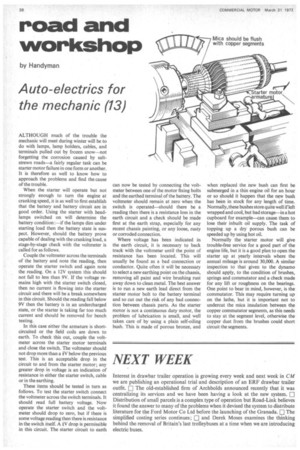road and workshop
Page 40

If you've noticed an error in this article please click here to report it so we can fix it.
by Handyman
Auto-electrics for the mechanic (13)
ALTHOUGH much of the trouble the mechanic will meet during winter will be to do with lamps, lamp holders, cables, and terminals pulled out by frozen snow—not forgetting the corrosion caused by saltstrewn roads—a fairly regular task can be starter motor failure in one form or another. It is therefore as well to know how to approach the problems and find the cause of the trouble.
When the starter will operate but not strongly enough to turn the engine at cranking speed, it is as well to first establish that the battery and battery circuit are in good order. Using the starter with headlamps switched on will determine the battery condition :—if the lamps dim under starting load then the battery state is suspect. However, should the battery prove capable of dealing with the cranking load, a stage-by-stage check with the voltmeter is called for as follows.
Couple the voltmeter across the terminals of the battery and note the reading, then operate the starter switch and again note the reading. On a 12V system this should not fall to less than 9V. If the voltage remains high with the starter switch closed, then no current is flowing into the starter circuit and there will be a break somewhere in this circuit. Should the reading fall below 9V then the battery is in an undercharged state, or the starter is taking far too much current and should be removed for bench testing.
In this case either the armature is shortcircuited or the field coils are down to earth. To check this out, couple the voltmeter across the starter motor terminals and close the switch. The voltmeter should not drop more than a IV below the previous test. This is an acceptable drop in the circuit to and from the starter motor; any greater drop in voltage is an indication of resistance in either the starter switch, cable or in the earthing.
These items should be tested in turn as follows. To test the starter switch connect the voltmeter across the switch terminals. It should read full battery voltage. Now operate the starter switch and the voltmeter should drop to zero, but if there is some voltage reading then there is resistance in the switch itself. A IV drop is permissible in this circuit. The starter circuit to earth can now be tested by connecting the voltmeter between one of the motor fixing bolts and the earthed terminal of the battery. The voltmeter should remain at zero when the switch is operated—should there be a reading then there is a resistance loss in the earth circuit and a check should be made first at the earth strap, especially for any recent chassis painting, or any loose, rusty or corroded connection.
Where voltage has been indicated in the earth circuit, it is necessary to back track with the voltmeter until the point of resistance has been located. This will usually be found as a bad connection or conductor. Quite often it will be necessary to select a new earthing point on the chassis, removing all paint and wire brushing rust away down to clean metal. The best answer is to run a new earth lead direct from the starter motor bolt to the battery terminal and so cut out the risk of any bad connection between chassis parts. As the starter motor is not a continuous duty motor, the problem of lubrication is small, and well taken care of by using a plain self-oiling bush. This is made of porous bronze, and when replaced the new bush can first be submerged in a thin engine oil for an hour or so should it happen that the new bush has been in stock for any length of time. Normally, these bushes store quite well if left wrapped and cool, but bad storage—in a hot cupboard for example—can cause them to lose their inbuilt oil supply. The task of topping up a dry porous bush can be speeded up by using hot oil.
Normally the starter motor will give trouble-free service for a good part of the engine life, but it is a good plan to open the starter up at yearly intervals where the annual mileage is around 30,000. A similar inspection to that given to the dynamo should apply, to the condition of brushes, springs and commutator and a check made for any lift or roughness on the bearings. One point to bear in mind, however, is the commutator. This may require turning up on the lathe, but it is important not to undercut the mica insulation between the copper commutator segments, as this needs to stay at the segment level, otherwise the copper dust from the brushes could short circuit the segments.




















































































